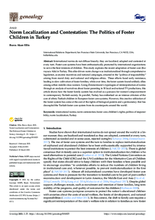Displaying 171 - 180 of 2214
The purpose of this study was to examine associations of foster care exit type (e.g., reunification with birth family, adoption, guardianship/permanent relative placement, or emancipation from care) with risk of entry into state prison in the U.S. state of Wisconsin and to examine racial disparities in those associations.
The current study aimed to examine effects of pre-adoptive risk on long-term functioning in children adopted from foster care.
The current study aimed to examine effects of pre-adoptive risk on long-term functioning in children adopted from foster care.
This study explores the recent adaptation of foster care (Koruyucu Aile) in Turkey.
The current study used survival analysis to simultaneously examine the influence of maltreatment characteristics on the risk of receiving a PTSD diagnosis at any time in care following entry into care.
This research focuses on Somalis living in a large English city where there is a significant shortage of Somali foster carers and adopters despite people of Somali heritage comprising a sizeable proportion of the care and city population.
The present study seeks to examine the goals that carers who are looking after children with emotional and/or behavioural difficulties set at the start of an intervention, the Reflective Fostering Programme, designed to support them.
This study examined the rates and correlates of first and repeat births in a national sample of females emancipating from foster care in the United States.
This study uses a retrospective pre/post design to measure the impact of the pandemic on foster carers’ self-care.
This study uses a retrospective pre/post design to measure the impact of the pandemic on foster carers’ self-care.

